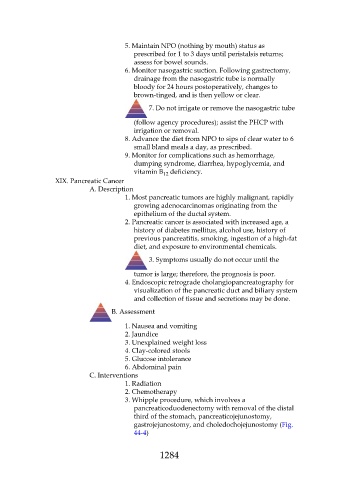Page 1284 - Saunders Comprehensive Review For NCLEX-RN
P. 1284
5. Maintain NPO (nothing by mouth) status as
prescribed for 1 to 3 days until peristalsis returns;
assess for bowel sounds.
6. Monitor nasogastric suction. Following gastrectomy,
drainage from the nasogastric tube is normally
bloody for 24 hours postoperatively, changes to
brown-tinged, and is then yellow or clear.
7. Do not irrigate or remove the nasogastric tube
(follow agency procedures); assist the PHCP with
irrigation or removal.
8. Advance the diet from NPO to sips of clear water to 6
small bland meals a day, as prescribed.
9. Monitor for complications such as hemorrhage,
dumping syndrome, diarrhea, hypoglycemia, and
vitamin B deficiency.
12
XIX. Pancreatic Cancer
A. Description
1. Most pancreatic tumors are highly malignant, rapidly
growing adenocarcinomas originating from the
epithelium of the ductal system.
2. Pancreatic cancer is associated with increased age, a
history of diabetes mellitus, alcohol use, history of
previous pancreatitis, smoking, ingestion of a high-fat
diet, and exposure to environmental chemicals.
3. Symptoms usually do not occur until the
tumor is large; therefore, the prognosis is poor.
4. Endoscopic retrograde cholangiopancreatography for
visualization of the pancreatic duct and biliary system
and collection of tissue and secretions may be done.
B. Assessment
1. Nausea and vomiting
2. Jaundice
3. Unexplained weight loss
4. Clay-colored stools
5. Glucose intolerance
6. Abdominal pain
C. Interventions
1. Radiation
2. Chemotherapy
3. Whipple procedure, which involves a
pancreaticoduodenectomy with removal of the distal
third of the stomach, pancreaticojejunostomy,
gastrojejunostomy, and choledochojejunostomy (Fig.
44-4)
1284

